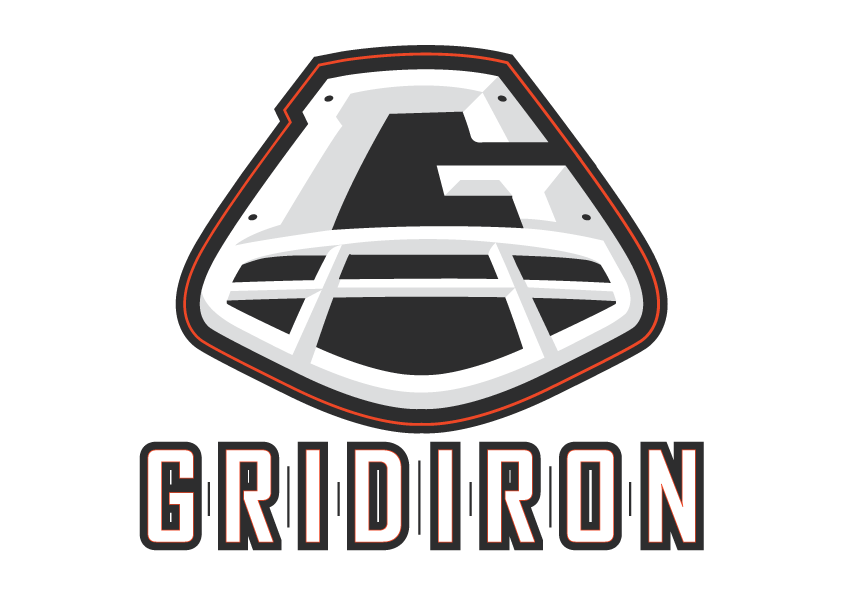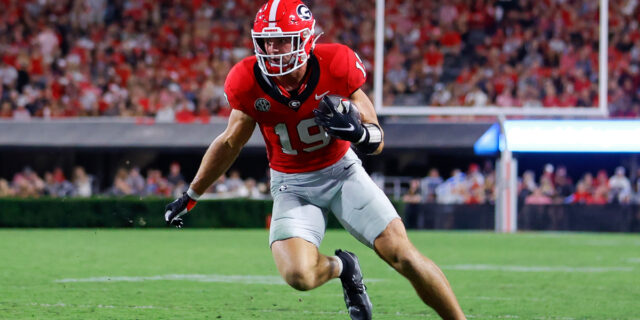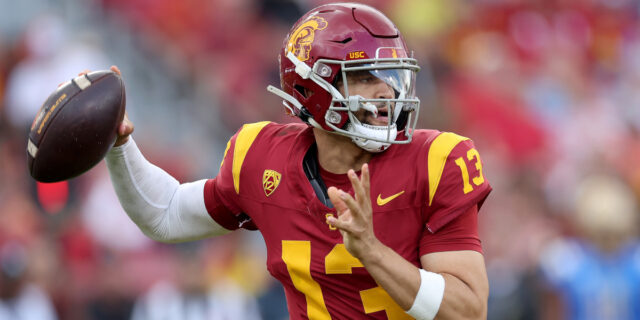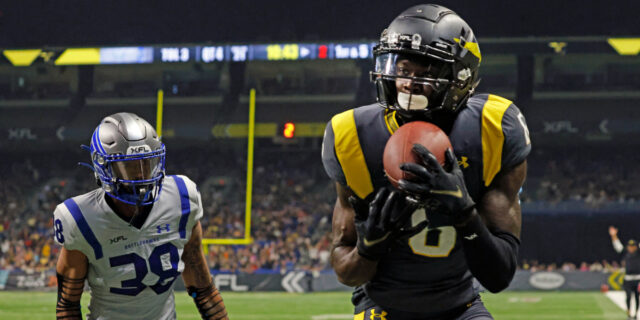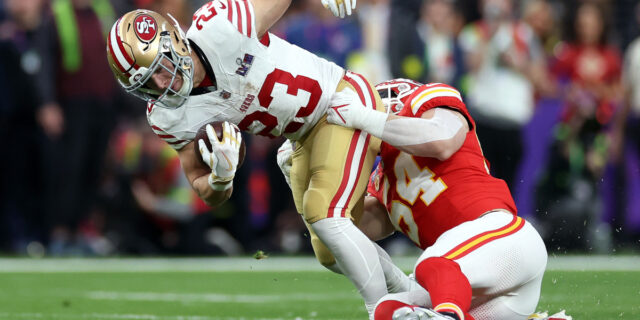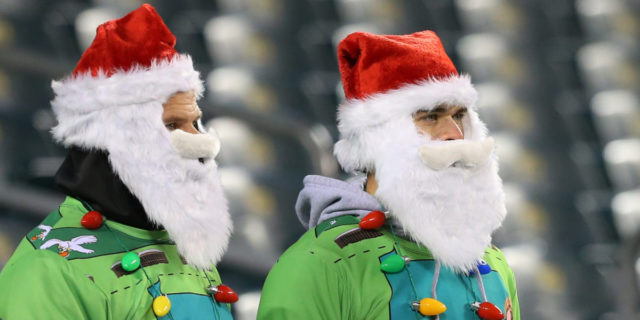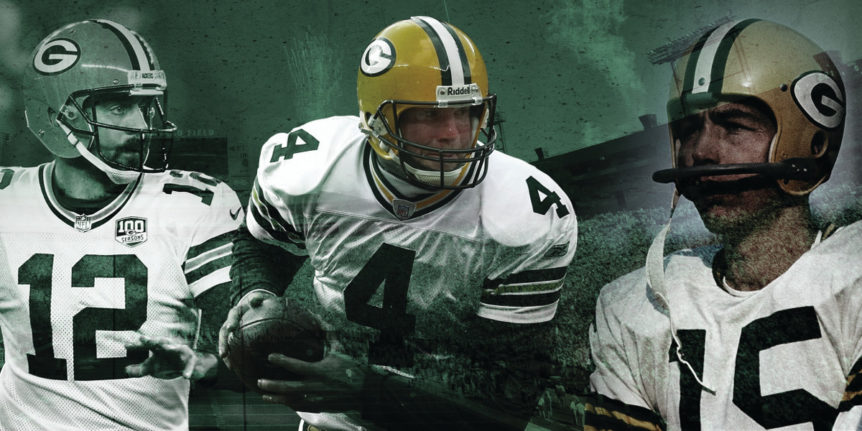
THE TOWN’S QBs…
The Green Bay Packers’ quarterback landscape over the last 30 years has been dominated by two men, Brett Favre and Aaron Rodgers. But who were the passers that came before them wearing the green, gold and white? Gridiron looks back at those who played under centre for the Packers and the stories behind them.
“Walking out the tunnel into Lambeau as the Green Bay quarterback for the first time was like trying to describe to someone how big a redwood tree is. You can’t! You have to be there to appreciate it.” Brett Favre to Gridiron, December 2018.
There have been 46 quarterbacks in the history of the Green Bay Packers. Five are in the Hall of Fame, with a sixth to be added once he retires. It’s an exclusive club of men who lead not just a franchise, but a town built on football. Its history drips from every corner of downtown, from the statue of Donald Driver outside Titletown Brewery to each stop along the Heritage Trail. From the bars and coffee shops, to the houses along Lombardi Avenue. Green Bay is different. And being the signal caller for the Packers is equally different. As Curly Lambeau once said: “You’re not just the quarterback of this team, you’re the quarterback of this town.”
Back in 1919, the world was recovering from World War I and the NFL wouldn’t be created for a year. But small towns, particularly those situated the industrial north, were becoming tiny hotbeds for a game that operated on the margins of society: pro football. Green Bay was no exception.
Several squads had come and gone during the years before the war, but none lasted. However, in the editorial room of the Green Bay Press Gazette, things changed forever, as Lambeau, who’d played for Knute Rockne at Notre Dame, was appointed ‘captain’ with Bill Ryan as coach. The Packers were born.
A month later they had their first game against the Menominee North End AC’s. Newspaper reports from the time state that Green Bay held on the AC’s first possession, forcing a punt before calmly driving down the field and scoring on a touchdown run from Dutch Dwyer. At quarterback was Lambeau. “The Packers used the forward pass to great advantage. Captain Lambeau was the main figure and his forward passes went true almost every time,” reported the Gazette.
Although statistics weren’t kept until the early 1930s, the Packers listed as ‘quarterbacks’ were Dwyer and Coffeen McLean. Teams played the single wing formation so the role of the QB was simply to take the snap and hand off – the act of throwing fell to the running back. A year later, in their first NFL (or APFA, as it was known) game against the Minneapolis Marines, Adolph Kliebhan was the ‘quarterback’. Again, though, it was Lambeau throwing passes from the halfback spot on the way to a 7-6 win.
The Packers’ first signal-caller of note was Charlie Mathys, a native of Green Bay who started 45 games between 1922 and ‘26. At just 5ft 8ins and 165lbs he was one of the smallest starting passers in Green Bay history and also may have also been the most cuckolded: after signing a contract with the team in 1921, Mathys wired a message to say that he’d be unable to join them because his wife wanted him to fulfil a commitment to a non-football job in Iowa.
It became a common theme; Mathys’ career came to an abrupt end five years later when his wife again took charge, telling him he needed to find a ‘real’ job and come home to start a family. But when he did play, Mathys was beloved by the fans, and the local press: “Mathys is rated as one of the best quarterbacks in the NFL,” wrote the Press-Gazette in 1924. “The brainy little field general was one of the sensations of Green Bay’s great 11 for the past two years. He is a wonderful field general and a splendid handler of the forward pass.”
For the next few years the Packers would go through a variety of quarterbacks, from Pid Purdy – the lightest player to ever throw a touchdown pass at 145lbs – to Red Dunn and Arnie Herber, who started with Green Bay as the team handyman and ended up under centre. It was Herber who would benefit from the early years of the great Don Hutson and, by 1936, they were the hottest passing combination in the league.
He led the NFL with 1,239 yards passing, becoming the first man to top 1,000 in league history, and 11 touchdowns. The Packers’ passing game was so dominant that Herber had outdistanced the second leading passer in the league by nearly 400 yards, and his 11 touchdowns were more than double the next best. Herber was the most prolific passer of the 1930s. His 6,749 yards and 66 touchdown passes between 1930 and ‘40 were the most in league history, and he led the NFL in passing yardage and touchdowns three times in five years between 1932 and ‘36. Though his records would be surpassed by Washington’s Sammy Baugh and Chicago’s Sid Luckman in the next decade, Herber’s accomplishments stand as spectacularly as Brett Favre’s and Aaron Rodgers’ would six decades later.
NFL offenses began to open up after World War II and the Packers were among those adapting by changing formation to the T and signing the first ‘modern’ QB in team history, Jack Jacobs from the Redskins. But it didn’t work: in 1948, he threw just five touchdowns and 21 picks and, the following year, departed to be replaced by Jug Girard and Stan Heath. But they, too, could only manage five touchdowns and 26 interceptions between them.
In an attempt to revitalise a once-great passing attack, Green Bay drafted Rice quarterback Tobin Rote in the second round and paired him with veteran Paul Christman from the Cardinals. The pair would combine to throw an astonishing 31 picks on just 350 attempts, an interception every 11 throws.
A year later, Green Bay revamped their system once more in an attempt to get the athletic Rote out on the perimeter more. He’d line up as much as 10 yards behind the centre, allowing the option to run or pass; by 1956, Rote was one of the best players in the game. That year he scored 29 total touchdowns, the highest figure in pro football history to that point. In fact, the rest of the team managed just five between them as Rote led the league in pass completions, pass attempts, passing yards, passing touchdowns, rushing attempts, rushing yards and rushing touchdowns. He’s somewhat lost in the mist because of what came after him, but Rote was a legitimate star at quarterback for the Packers and unlucky not to be in the Hall of Fame. He left Green Bay, won a championship with Detroit and then in the CFL with Toronto.
A man who could have starred was Charlie Brackins, a 16th-round pick in the 1955 NFL Draft and the first African-American quarterback in the modern history of the NFL. But he lasted only seven games and threw just two passes before being cut and never hooked up with another team. Brackins is the stuff of legend: mobile and possessing a cannon for an arm, he ran into trouble off the field with curfew violations and rumours he was dating white women in small-town Green Bay – which ran him afoul of the coach. In a different era, Brackins might have been a superstar, but in Titletown he was simply passing through.
Brackins had been found by one of the unsung legends of Packers history, head of personnel Jack Vainisi. Responsible for the vast majority of players that were integral to Vince Lombardi’s reign, it’s arguable that he could be the third-most important man to ever work for the organisation behind Lombardi and Lambeau. Consider the players Vainisi drafted: Jim Ringo in 1953, Forrest Gregg in ‘56, Paul Hornung in ‘57 and Jim Taylor, Ray Nitschke and Jerry Kramer in ‘58. He also signed Willie Wood as an undrafted free agent and facilitated trades for Willie Davis and Henry Jordan. All are in the Hall of Fame.
In addition, Vainisi drafted Max McGee, Bob Skoronski, Hank Gremminger, Ron Kramer, Dan Currie, Boyd Dowler, Tom Brown and Bob Jeter, all of whom would start on championship teams. When he died aged just 33 of heart failure in 1960, he told Lombardi on his death bed that he had to select cornerback Herb Adderley in the upcoming draft. Adderley went on to become Vainisi’s ninth Hall-of-Fame pick.
His third came four years earlier in 1956 with a lowly 17th rounder from Alabama called Bryan Bartlett Starr, who the Pack liked as much for his punting skills as anything else. He’d been injured so much as a quarterback that his ability under centre was something of an afterthought, although Vainisi thought the Crimson Tide passer might be something special if he could stay healthy. Five NFL Championships, two Super Bowls, two Super Bowl MVP awards, four Pro Bowls and five passing titles later, it was clear Vainisi was onto something.
There were 21 years between Starr’s retirement in 1971 and the trade which brought Favre to Green Bay from Atlanta. In that time, the Packers started 17 quarterbacks, including Jim Del Gaizo, who’d been the back-up in Miami during their undefeated season; Carlos Autrey, who went on to appear in The A-Team and The Dukes of Hazzard; and John Hadl, the sore-armed 34-year-old who Green Bay inexplicably traded two ones, two twos and a three for in 1974.
The deal for Hadl happened only because a move for Archie Manning fell through. Green Bay, believing they’d secured the services of the third-year Ole Miss star after he had been benched for back-up Bobby Scott, sent assistant Bill Tobin to seal the deal. But Scott blew out his knee and the Saints reneged. “We played the Falcons and Scotty got hurt and that nixed it,” Manning would later say. “I was in the middle of all that trade stuff. I was being shopped and I remember there were several things going on with the Giants, 49ers, Saints and Rams. But I heard it was Green Bay.”
Without Manning, the task of leading the Pack for much of the next decade until Favre’s arrival went to Lynn Dickey – acquired in a trade for Hadl in 1976 – and Don Majkowski. Dickey was an unheralded member of the famous Class of ‘71 QBs that included Jim Plunkett, Manning, Dan Pastorini and Ken Anderson, and he threw for more than 20,000 yards, including an All-Pro 1983 season where he led the league in touchdown passes with 32.
Majkowsi was a 10th-round afterthought who had one ‘Majik’ season in 1989 before suffering a serious shoulder injury that ultimately ended his career, throwing for 4,318 yards to lead the league and beating the Bears for the first time since 1984 on a broken play at the end of the game where he scrambled out of trouble and hit Sterling Sharpe for the game-winner to cement his legacy. Perhaps the greatest footnote to his career was that, a season before his breakout campaign, Majkowsi led the Packers to a shock win over the Cardinals in the final game of the year, costing Green Bay the first overall pick in the ‘89 draft. That selection? Troy Aikman. If the Packers had lost that game, they likely never trade for Favre and NFL history would have been very different.
Aikman – and Archie Manning – weren’t the only star passers the Packers missed out on. Back in 1979, Red Cochran, the Packers’ Midwest scout at the time, tried to convince then head coach Bart Starr to take the Notre Dame passer. “I can remember Red saying, ‘Bart, all this guy does is win. I’ve watched him for four years, he just wins,’” said Bob Harlan, the Packers GM at the time. “When Starr passed on Montana for the second time, Cochran walked out of the draft room in a huff.”
It turned out to be a huge mistake. Starr, who had a spotty personnel record and would later pass on Ronnie Lott, wrote in 1987 of his regret for passing on the future Hall of Famer. “We gave a lot of thought about taking him. There is no question that I made a terrible mistake in passing on Joe Montana in 1979. He could play, and I knew it, and I blew it.”
Yet the bad luck and judgement of those misses has been made up for ever since, Green Bay having enjoyed a near-three-decade run with Hall of Famers under centre. Two Super Bowls during that time might never be enough to satisfy Titletown but, in Aaron Rodgers and Brett Favre, the Packers have added another pair of elite names to their amazing history under centre.
This article originally appeared in Issue XLIII of Gridiron magazine – for individual editions or subscriptions, click HERE
